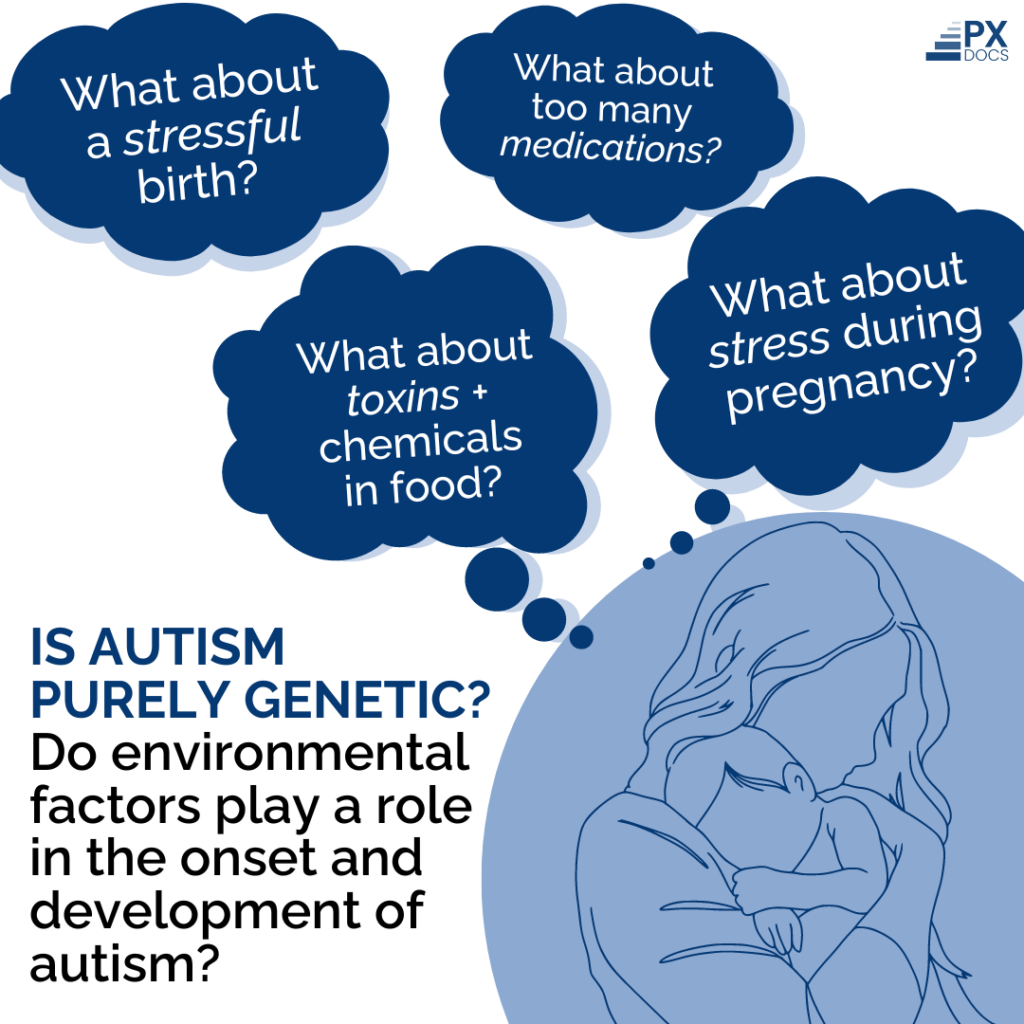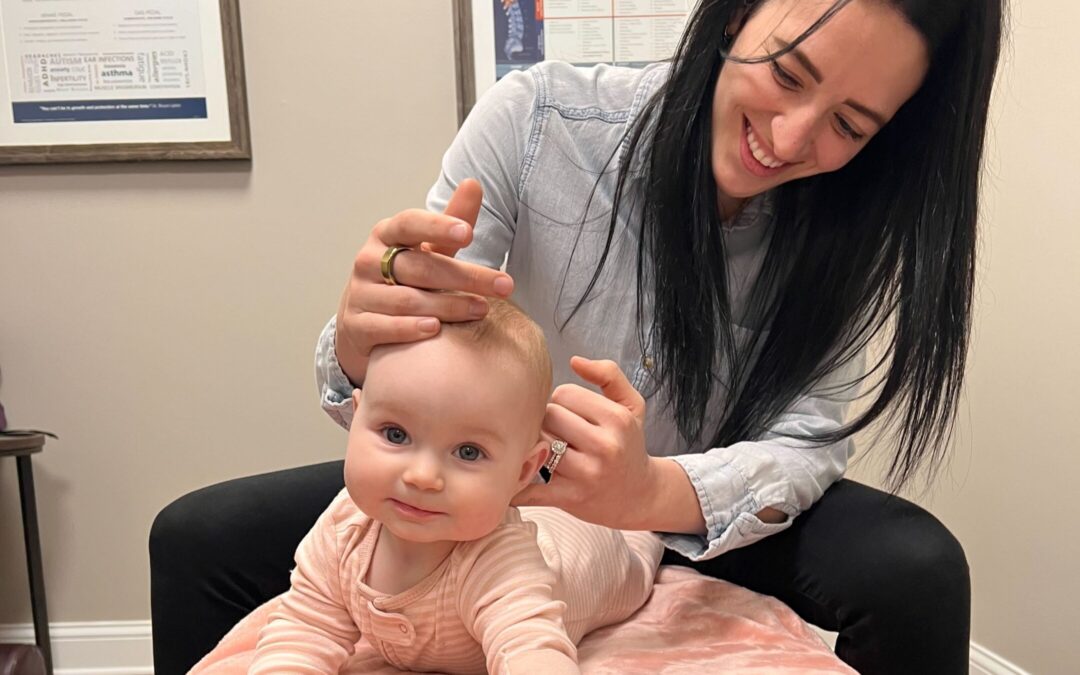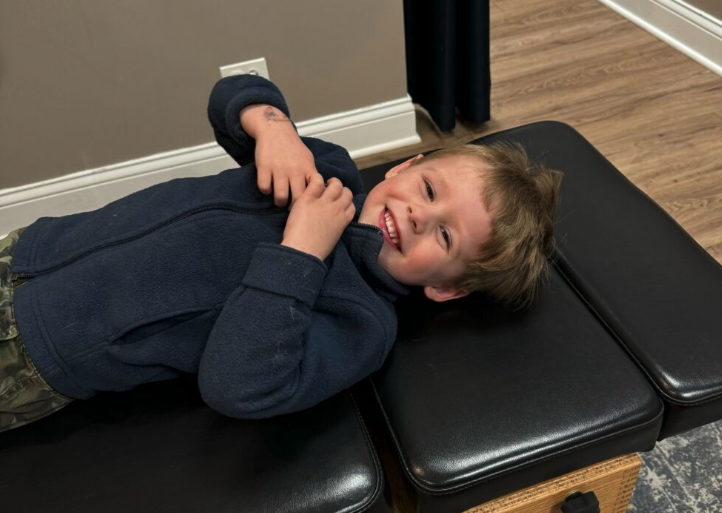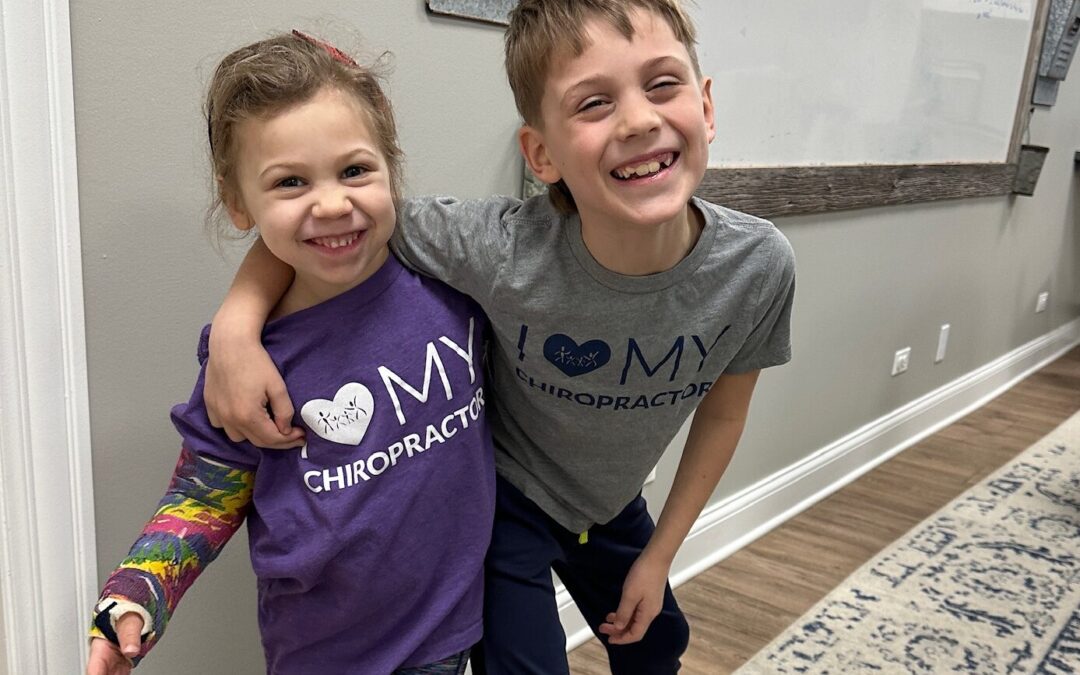Autism spectrum disorder diagnoses are on the rise, with recent statistics estimating 1 in 44 children are identified as having autism. Both parents and doctors alike often default to the assumption that the increase must be due to genetics and heritable causes that are now just being recognized and diagnosed better. However, while genes can raise risk, they fail to tell the whole story. Overlooked environmental and neurodevelopmental factors may play an equal or greater role. This article explores the common question, “is autism genetic?” and what that really means. It evaluates the latest evidence and highlights the gaps that a nervous system-based approach like PX Docs aims to fill with cause-based, functional care.
When confronted with an autism diagnosis or concerns over their child missing developmental milestones, understandably, the first question on most parents’ minds is – why?
A common refrain they hear in response from mainstream medicine is that autism is genetic, implying children likely were simply born “that way,” and little can be done beyond basic adaptation and symptom management. However, that narrative only skims surface levels of a condition now believed to emerge from a complex interplay of genetic vulnerabilities and environmental influences that ultimately physically alter nervous system development. This leads to communication challenges, speech delays, sensory issues, behavioral struggles, and more. While genetics are involved, science shows risk depends just as much, if not more, on other factors. Recognizing this empowers parents so they understand what care components are necessary for their child to overcome challenges and reach their full potential.
Core Characteristics and Symptoms of Autism
Autism spectrum disorder (ASD) refers to a developmental disability characterized by difficulties with communication, social interactions, restrictive/repetitive behaviors, and sensory processing issues. It is considered a spectrum because of the wide variation in types and severities of symptoms individuals can exhibit. Key characteristics include:
- Communication deficits: this may present as delayed or absent speech, narrow vocabulary, lack of nonverbal cues, monotone voice, or improper conversational flow.
- Social challenges: difficulty reading facial expressions/emotions, making eye contact, developing relationships, empathizing, or picking up on social norms are common.
- Restrictive, repetitive behaviors: hand flapping, rocking, obsession with specific items/topics, extreme distress at small changes, and ritualistic habits fall in this domain.
- Sensory processing differences: hyper/hyposensitivity to sounds, textures, smells, and tastes that disrupt learning and behavior.
While skill levels lie across a continuum, these core symptom areas inevitably lead to impacts on an overall developmental trajectory that can benefit from early identification as well as targeted, cause-based care. But simply correlating autism severity with genetic causality fails to capture the full picture.
What Does It Mean for Autism to be Genetic?
When experts state autism is a genetic disorder, they are implying someone is born with certain gene variants that make developing ASD much more likely later in childhood when those genes eventually express themselves after conception and birth. However, this strictly genetic causality view has come under scrutiny in recent years.
No single “autism gene” has been discovered. Twin studies and heritability estimates also do not conclusively isolate genes as autism’s sole origin. Secondly, even supposed high-risk genetic markers like chromosome deletions/duplications, metabolic disorders, or Fragile X are absent in up to most autism cases. The remaining majority of instances, often labeled idiopathic (no known cause), continue without definitive explanation if only viewing autism as determined at conception.
Instead, a multi-factorial model better explains most occurrences on the spectrum. One in which vulnerable genes increase relative risk but require environmental triggers to push a child’s development over the threshold into disability. This view aligns with the rising recognition from scientific literature that nervous system factors play a central role in ASD, often sparked by challenges during the prenatal, birth, and postnatal periods.
At PX Docs, we refer to this multi-factorial model as the “Perfect Storm,” where it’s not just the summation of environmental factors that play a role, but more specifically, how early (when) a child is exposed to these factors, and in what order or sequence they occur. To learn more about this “Perfect Storm” theory and scientific model of autism, be sure to check out this in-depth article as well.
Evaluating the Genetic Evidence
The advancement of genomic sequencing techniques over the past decade has enabled more intensive study of autism’s genetic components. Techniques like whole exome sequencing, copy number variant analysis, and genome-wide association studies search for both inherited and spontaneous mutations linked to a higher incidence of ASD.
These tools have successfully identified rare variants in over 100 genes tied to elevated autism risk. Examples include genes regulating brain development pathways, synaptic function, and chromatin remodeling processes. Common variants in over 1,000 other genes also seem to modestly increase vulnerability.
Overall, it is estimated that 5%-14% of autism cases have a known single-gene cause. However, clinical interpretation of results remains challenging. Only a handful of mutations emerge in actual ASD-related genes. Most surface in completely unrelated genes or those with functions we simply don’t fully grasp yet to make a definitive diagnosis.
Furthermore, if autism was mainly linked to clear and certain genetic issues, the rapid increase in autism rates over the last 40 years appears confusing. Genes alone fail to account for a near 30-fold increase in just a few decades. This highlights how environmental influences likely carry significant weight as well by triggering the expression of latent genetic risks, disrupting normal metabolism, inflicting physical trauma during development, or causing direct epigenetic changes.
Complex Interplay Between Genes and Environment
Rather than genetics serving as the sole origin, the prevailing scientific view recognizes autism as resulting from an accumulation of multiple genetic and environmental risk factors converging to disrupt normal neurological development. This aligns with our “Perfect Storm” analogy describing the sequence of stressful events many children face beginning in pregnancy that brew into later challenges.

For instance, strong links exist between maternal psychological distress prenatally and offspring neurodevelopmental issues. High cortisol and inflammation may impair fetal brain growth, while anxiety potentially alters vagus nerve maturation, disrupting future nervous system regulation. Assisted reproductive technologies like IVF also carry higher risks of autism, perhaps due to factors like fertility medications, embryo manipulation, or higher rates of premature birth.
Birth complications provide further injury to an already vulnerable nervous system. Trauma from interventions like vacuum extraction or C-sections may damage the brainstem or vagus nerve. Hypoxia from distress or prematurity can destroy neurons and white matter. These acute impacts ripple into long-term developmental delays.
Later environmental exposures like infections, antibiotics, toxins, poor nutrition, stress, and physical trauma sustain dysfunction. Eventually, a tipping point alters neurological wiring enough to manifest as autism’s hallmark symptoms. While genetics set the stage, the “Perfect Storm” brewing after conception likely determines if otherwise latent risks convert into active disability.
Nervous System Dysfunction Connections
If autism emerges from accumulated stress disrupting foundational neurological development, detecting points of dysfunction along the way can facilitate cause-based interventions. Here, the concepts of subluxation and dysautonomia become highly relevant.
Subluxation refers to misalignments and tension buildup affecting the central nervous system and nerve roots, often originating from birth injury or trauma. This impairs nerve signaling, tone regulation, sensory processing, and more. Dysautonomia denotes an imbalance between key nervous system branches, stuck in fight-flight overdrive with impaired calming capacity.
Together they comprise a “wired and tired” central network unable to optimally coordinate body systems. Digestion falters from vagus nerve dysregulation. Inflammation and allergies manifest from an imbalanced immune system. Behavior and emotions spiral out of control with a revved-up sympathetic state and suppressed parasympathetic input. All hallmarks of disorders like autism and ADHD.
Specialized INSiGHT Scans from PX Doc, like the NeuroThermal, NeuroSpinal EMG, and Heart Rate Variability assessments, detect signs of subluxation and dysautonomia missed by genetic screens and can find these neurological dysfunctions with pinpoint accuracy. Identifying nerve interference and dysfunction this way provides a functional biomarker for nervous system performance underlying symptoms, helping our PX Docs build targeted and customized care plans for each unique individual autism patient, rather than just labeling it as genetic and recommending the same cookie-cutter plan for every patient.
Caring For the Whole Child
Confronted with rising rates of conditions like autism, the default medical response has centered on improving diagnosis and labels, not refining care. This overemphasis on genetics risks perpetuating a form of clinical tunnel vision, missing the forest through the trees when it comes to children’s needs.
Considering autism as an inherent aspect woven into one’s DNA allows for a perspective of care models focused more on adapting to disability than promoting development. This manifests as reliance on psychiatric medications for behavior and emotional regulation or pushing compliance-based therapies trying to force children into boxes labeled “normal” rather than improving underlying function.
However, emerging science recognizes autism as a dynamic syndrome involving alterations in neurological development from their “Perfect Storm,” not permanently damaged wiring. Pursuing neurological healing and recovery means addressing the roots of that stress, injury, and imbalance disrupting neurological communication, connectivity, and processing capacity.
Care centered around detecting and reducing subluxation, nurturing nervous system plasticity, resolving inflammation, and retraining faulty sensory-motor pathways provides the comprehensive support children with autism truly need. With nervous system function governing all other foundational systems of the body, concentrating efforts here first facilitates global gains in digestion, motor planning, cognition, immunity, and beyond.
The multi-faceted protocols used within the PX Docs network aim to do just that – care for the whole child, not just treat isolated symptoms. A nervous system focus delivers hope that with the right stimulation and lifestyle adjustments tailored to their specific neurological dysfunction patterns, children can overcome developmental disabilities and achieve incredible levels of recovery and improved quality of life!
Shifting the Care Paradigm
When over 90% of conventional autism research focuses on genetic origins, yet 80% of cases have no identified genetic marker, gigantic gaps in clinical wisdom emerge that hinder children’s care. The nervous system coordinates all other body systems yet remains untapped for its restorative potential. Moving beyond labels enables optimizing function as the goal instead of cataloging dysfunction.
Families simply want to improve their child’s gut and immune health, communication capacity, emotional regulation, cognitive connectivity, and sensory-motor flow. Gentle adjustments addressing tension build-up, misalignments, and imbalance sending signals awry can re-establish central nervous system coordination over time. New pathways form, and existing ones strengthen and gain compound. With the plasticity of youth, the right stimulation facilitates development, not just adaptation.
The Takeaway on Genetics and Autism
In summary, while genetic factors undoubtedly influence autism risk, they fail to fully account for recent surges in prevalence or variations in outcomes. Clinging to the notion that autism begins and ends with inherited mutations limits perspectives on care options for families simply seeking to improve their children’s quality of life.
Instead, the current scientific consensus recognizes autism as originating from an accumulation of prenatal, perinatal, and postnatal stress events that derail the establishment of smooth nervous system signaling. This “Perfect Storm” brews over months and years, not arising spontaneously from conception. Appreciating that story and science empowers parents because it means lasting changes remain possible through care protocols targeting neurological regulation, development, and function.
However, most in the traditional medical world still overlook the nervous system as the boss of all other foundational systems of the body. Without addressing nervous system function or dysfunction, which specialized scans from PX Docs provide, it will be challenging to get to the root cause.
Neurologically-Focused Chiropractic Care and our gentle but effective adjustments should rank first when designing care plans, not last. This contrasts with traditional approaches prioritizing labels and medications over improvement. Shifting perspective to view autism as a dynamic, not predetermined condition offers renewed hope for your child to unlock their full potential.





